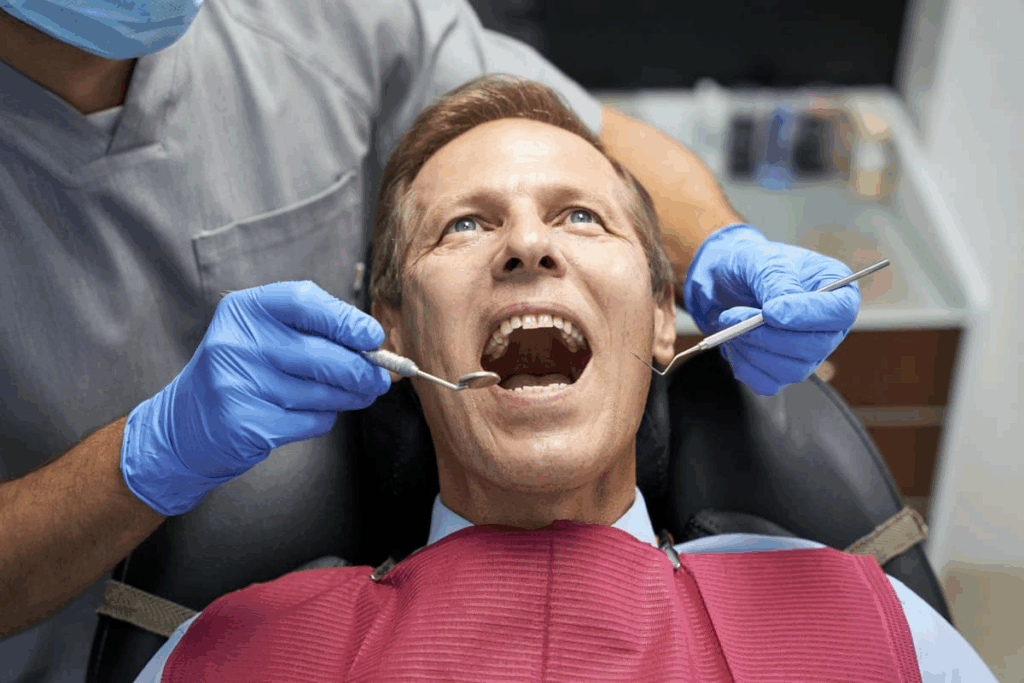Last Updated on November 27, 2025 by Ugurkan Demir

Oropharyngeal cancer is a big health issue worldwide. It has big effects on survival outcomes. The American Cancer Society says about 59,660 new cases will happen in the U.S. in 2025. Sadly, around 12,770 people will die from it.
What is the oropharyngeal cancer survival rate? Learn the prognosis, which is often better for HPV-positive cases.
The five-year survival rate for oropharyngeal cancer is about 52 percent. This shows a moderate chance of survival. It depends on the cancer’s stage and if it’s caused by HPV. Knowing these survival rates is key for both patients and doctors.

It’s important to know about oropharyngeal cancer for early detection and treatment. This cancer affects the oropharynx, which is the middle part of the throat.
The oropharynx is key for swallowing and breathing. It includes the base of the tongue, tonsils, soft palate, and throat walls. Oropharyngeal cancer happens when cells in this area grow out of control, forming tumors that can spread.
Oropharyngeal cancers are classified by the cells affected. The most common is squamous cell carcinoma, from squamous cells. Less common types include adenocarcinoma and lymphoma.
Type of Cancer | Description |
Squamous Cell Carcinoma | Arises from squamous cells lining the oropharynx |
Adenocarcinoma | Originates from glandular cells |
Lymphoma | Affects the immune cells in the oropharynx |
Several factors increase the risk of oropharyngeal cancer. Human Papillomavirus (HPV) infection is a big risk factor, mainly for tonsil and base of the tongue cancers. Other risks include tobacco use, heavy alcohol, and a diet low in fruits and veggies.
“HPV is now recognized as a major risk factor for oropharyngeal cancer, and its incidence is rising in many parts of the world.”
Knowing these risk factors helps in prevention and early detection. Healthcare providers can screen and prevent more effectively for those at high risk.

Oropharyngeal cancer in the United States shows a complex picture. It’s a type of head and neck cancer with unique characteristics. Knowing these helps us understand its impact and plan better health strategies.
Oropharyngeal cancer is a big health issue in the U.S. The trends in who gets it and who dies from it are changing. This shift is important to note.
The American Cancer Society says about 59,660 new cases of oral or oropharyngeal cancer will be diagnosed in 2025. This highlights the need for ongoing research and awareness.
Unfortunately, oropharyngeal cancer also leads to a lot of deaths each year. With 12,770 deaths expected in 2025, it’s key to understand why. This knowledge can help improve treatment outcomes.
Oropharyngeal cancer has specific patterns in who gets it. It’s more common in men and White people than in women and Black people. This shows gender and ethnicity play a part in risk.
To better understand these patterns, let’s look at the data in a table:
Demographic Group | Incidence Rate | Mortality Rate |
Men | Higher | Higher |
Women | Lower | Lower |
White | Slightly Higher | Varies |
Black | Slightly Lower | Varies |
The data on oropharyngeal cancer in the U.S. shows we need focused health strategies. By understanding the current stats, trends, and patterns, we can improve care for those with oropharyngeal cancer.
Understanding oropharyngeal cancer diagnosis and staging is key to finding the right treatment. Early detection is critical for better survival chances. It’s important to know the common symptoms and warning signs.
Oropharyngeal cancer symptoms can be tricky to spot early. Common signs include:
These signs can also mean other health issues. But, it’s vital to see a doctor if they don’t go away.
To diagnose oropharyngeal cancer, doctors use several methods:
The TNM system stages oropharyngeal cancer. It looks at:
The TNM values help figure out the cancer’s stage. This is key for treatment planning and predicting outcomes. Here are the stage groupings:
Stage | TNM Classification | Description |
I | T1, N0, M0 | Early-stage cancer, limited to the oropharynx |
II | T2, N0, M0 | Cancer has grown but not spread to lymph nodes |
III | T3, N0, M0 or T1-3, N1, M0 | Cancer has grown larger or spread to lymph nodes |
IV | T4, N0-1, M0 or Any T, N2-3, M0 or Any T, Any N, M1 | Advanced cancer, potentially spread to distant sites |
Getting the cancer stage right is essential. It helps choose the best treatment and predicts recovery chances.
Knowing the survival rates for oropharyngeal cancer is key for both patients and doctors. The survival rate for this cancer has gotten a lot of attention. This is because it affects how we treat and care for patients.
The five-year survival rate for oropharyngeal cancer is about 52 percent. This means that about 52 percent of people with this cancer can live for at least five years after being diagnosed. This is compared to people without this cancer.
The American Cancer Society says the five-year survival rate is a key measure for cancer patients. This rate changes based on when the cancer is found and the patient’s health.
Survival rates for oropharyngeal cancer have gotten better over the last ten years. This is true, more so for HPV-positive cases. Studies show that HPV-positive cases have better survival rates than HPV-negative ones.
HPV-positive oropharyngeal cancers are more likely to respond well to treatment. This shows how important knowing the HPV status is for predicting outcomes.
Oropharyngeal cancer has better survival rates compared to other head and neck cancers. For example, cancers of the oral cavity and larynx have different survival rates. This is because they have different biological features and treatment responses.
It can be hard for patients to understand survival statistics. Each person’s experience can be different from the overall numbers. It’s important for patients to talk to their doctors about their own situation and treatment options.
“Survival statistics are based on large groups of people, but individual experiences can differ. Patients should consult their healthcare team to understand their personalized prognosis.”
By knowing the survival rates and trends for oropharyngeal cancer, patients and doctors can make better choices about treatment and care.
The stage of oropharyngeal cancer diagnosis greatly affects survival rates. It’s key for patients and doctors to understand these rates. This helps in making the best treatment and care plans.
Patients with localized oropharyngeal cancer have a five-year survival rate of 83.7%. This shows how vital early detection is when the cancer is only in its original place.
For oropharyngeal cancer that has spread to nearby tissues or lymph nodes, the survival rate drops to 64.2%. This rate points out the difficulty in treating cancer that has spread.
Patients with distant metastatic oropharyngeal cancer face a five-year survival rate of 38.5%. This lower rate stresses the need for early treatment before the cancer spreads.
The big difference in survival rates between localized, regional, and distant metastatic disease shows early detection’s importance. A study notes, “Early diagnosis is key for effective treatment and better survival in oropharyngeal cancer patients.”
“The prognosis for oropharyngeal cancer patients largely depends on the stage at diagnosis, making early detection a vital component of effective cancer management.”
We need to keep raising awareness about oropharyngeal cancer risks and symptoms. This helps in diagnosing it earlier and boosting survival rates.
Knowing how HPV status affects oropharyngeal cancer survival is key. It helps us understand prognosis and treatment success. HPV-positive oropharyngeal cancers have a much better outlook than HPV-negative ones.
Research shows that HPV-positive patients have survival rates over 80 percent. In contrast, HPV-negative patients’ survival rates are under 50 percent. This big difference shows how important HPV status is in survival rates.
When we talk about mouth cancer prognosis, HPV status matters a lot. Patients with HPV-positive oropharyngeal cancer usually have a better chance of survival. This knowledge can guide treatment choices and improve survival chances.
Understanding HPV status and its effect on survival is vital. It helps both patients and doctors make better treatment plans. By recognizing the survival rate gap between HPV-positive and HPV-negative patients, we can aim to better outcomes for all.
The five-year survival rate for oropharyngeal cancer is about 52 percent.
Survival rates change a lot based on the cancer’s stage. For localized disease, the survival rate is 83.7%. For regional disease, it’s 64.2%. And for distant metastatic disease, it’s 38.5%.
Patients with HPV-positive oropharyngeal cancer have a much better chance of survival. This shows how important HPV status is for treatment outcomes and survival rates.
Yes, oropharyngeal cancer can be fatal. But, the chance of survival depends on the cancer’s stage and HPV status.
How long you can live with oropharyngeal cancer depends on its stage and HPV status. Early detection and treatment can greatly improve your chances of survival.
The prognosis for oropharyngeal cancer is moderate. The five-year survival rate is about 52 percent. It varies based on the disease’s stage and HPV status.
Oropharyngeal cancer can be deadly. But, early detection and treatment can improve your chances of survival. HPV-positive patients have a better prognosis.
The life expectancy for oropharyngeal cancer patients depends on the disease’s stage and HPV status. The five-year survival rate is about 52 percent.
The survival rate for stage 3 oral cancer is around 64.2% for regional disease. But, it can vary based on individual factors.
Yes, many people survive oropharyngeal cancer. Early detection and treatment are key. HPV-positive patients have a better chance of survival.
Oropharyngeal cancer can be fatal. But, the prognosis varies based on the disease’s stage and HPV status. Early detection and treatment can improve your chances of survival.
National Center for Biotechnology Information.. What Is the Survival Rate for Oropharyngeal Cancer.https://www.ncbi.nlm.nih.gov/pmc/articles/PMC10807619/
Subscribe to our e-newsletter to stay informed about the latest innovations in the world of health and exclusive offers!